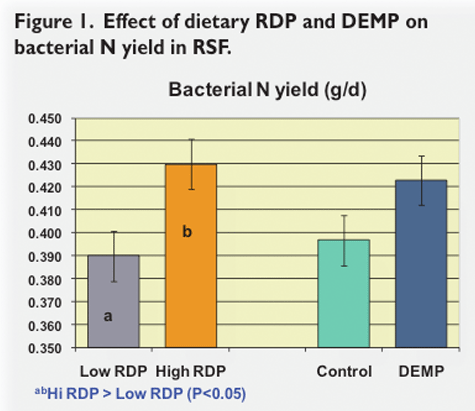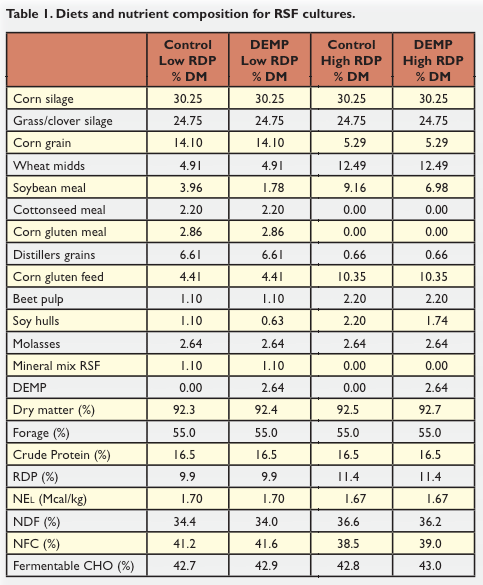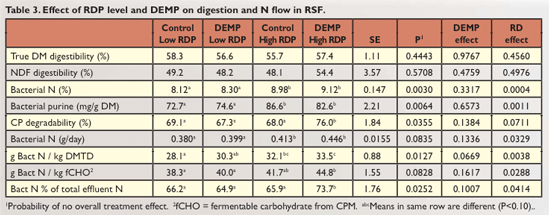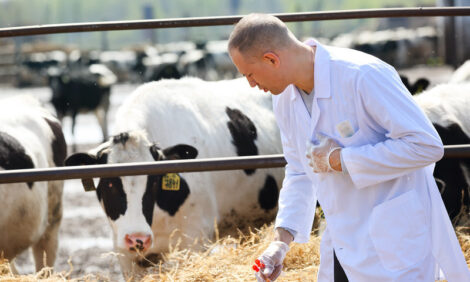



Effect Of DEMP On Fermentation, Digestion And Rumen-Stimulating Fermentors
G Harrison, M Meyer and K Dawson from Alltech looked at the effect of dietary escape microbial protein (DEMP) on the rumen, when replacing soybean meal (SBM).Objective
Compare ruminal fermentation, digestion, and N flow in rumen-simulating cultures fed diets based on SBM or DEMP and formulated at 2 levels of ruminally degradable protein.
Experimental Protocol
- Twelve (12) cultures were used in a 2 X 2 factorial design with 4 treatments and 3 replicates per treatment.
- Cultures were charged with approximately 1000 ml of ruminal fluid strained through 4 layers of cheesecloth and collected from a heifer fed a 70 per cent forage diet (DM basis).
- Cultures were fed 25 g (as fed) of experimental diets for 6 days.
- The flow rate for modified McDougall’s artificial saliva solution without urea (70 per cent buffer solution and 30 per cent tap water) was maintained at approximately 45 ml/hr.
- Experimental diets and calculated nutrient composition is shown in Table 1.
- Inclusion rate for DEMP was equivalent to 600 g DM at 22.7 kg DM intake and DEMP replaced primarily soybean meal.
- Culture pH and ammonia concentration were measured immediately prior to morning feeding on d 4-6. On day 5, pH was measured and a 1 ml sample collected for ammonia at 0, 1, 2, 4, 6, and 8 h postfeeding.
- Effluent samples were collected on d 4-6 with samples composited and freeze-dried for calculation of DM and NDF disappearance. Samples for VFA analyses were collected at the same time points.
- Bacterial cells from each culture (separated by centrifugation) were freeze-dried and analyzed for DM, N, and purine. Freeze-dried effluent samples analyzed for DM, N, and purine.
- Data were analyzed as a 2 X 2 factorial design using the GLM of SAS. Orthogonal contrasts were used to separate effects of RDP level and N source.

Results
- Cultures fed DEMP diets had lower isoacid molar proportion (P<0.05) and lower ammonia concentrations compared to those fed SBM (P<0.10) (Figure 1).
- Bacterial N yield tended to be greater in cultures fed DEMP (P<0.15) and efficiency of bacterial N production based on true DM digested was greater in DEMP-fed cultures (P<0.10).
- RDP level did not affect digestion (P>0.10) but did alter fermentation and N flow.
- Higher RDP cultures had more acetate (P<0.01), less propionate (P<0.05), and less isoacids (P<0.01) on a molar proportion basis.
- Cultures fed higher RDP diets had higher ammonia concentrations (P<0.001) (Figure 2).
- With regards to N flow measures, higher RDP diets produced more bacterial N (P<0.05), had higher proportion of effluent N from bacteria (P<0.05), and produced bacterial N with greater efficiency based on both truly digested DM (P<0.01) and fermentable CHO fed (P<0.05).

Summary
- The primary objective of this experiment was to evaluate effects of DEMP replacement of SBM on ruminal metabolism in diets formulated for low or high RDP.
- Replacing SBM with the equivalent of 600 g of DEMP had no impact on ruminal fermentation.
- Replacement of SBM with DEMP resulted in numerical improvements in both low and high RDP diets (+5.1 and +7.4 per cent, respectively).
- The increase in measured RDP was similar to the calculated dietary RDP and did translate into a 10.3 per cent increase in bacterial N in the higher RDP diets.
- The inclusion of DEMP in higher RDP diets resulted in more protein degraded and a greater proportion of effluent N from bacteria compared to SBM-based diets. However, this was not the case when DEMP was fed with lower RDP (interaction; P<0.05). These interactions suggest that DEMP may have a more positive effect when fed in higher RDP diets.





